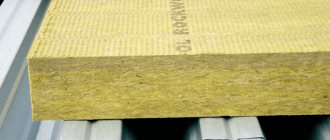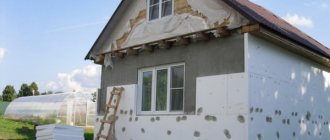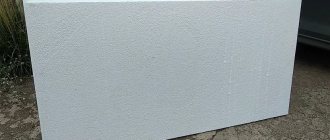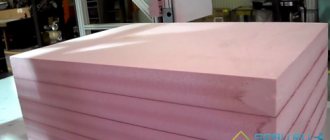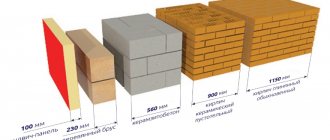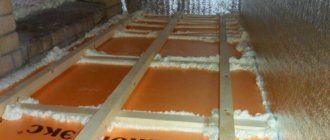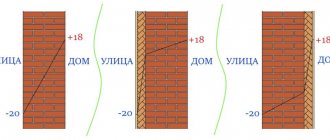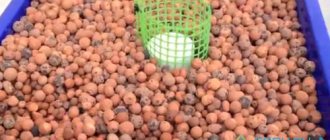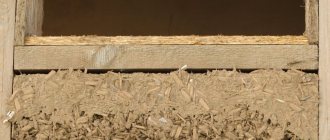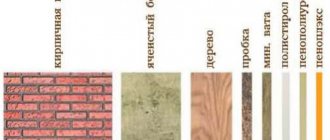In the modern world, an important aspect of a private home is its energy efficiency. That is, the ability to spend a minimum amount of energy to maintain a comfortable climate in the house. To spend less energy, you need to take care of reducing energy losses.
Thermal conductivity of materials is the ability of a material to retain heat in cold weather and keep cool in summer.
Heat capacity is the amount of heat absorbed (released) by a body in the process of heating (cooling) per 1 kelvin.
Density is the ratio of the mass of a body to the volume occupied by this body.
Thermal conductivity.
So what is thermal conductivity? From a physics point of view, thermal conductivity
– this is the molecular transfer of heat between directly contacting bodies or particles of the same body with different temperatures, in which the energy of movement of structural particles (molecules, atoms, free electrons) is exchanged.
To put it simply, thermal conductivity
is the ability of a material to conduct heat. If there is a temperature difference inside the body, then thermal energy moves from the hotter part of the body to the colder part. Heat transfer occurs due to the transfer of energy when molecules of a substance collide. This happens until the temperature inside the body becomes the same. This process can occur in solid, liquid and gaseous substances.
In practice, for example in construction for the thermal insulation of buildings, another aspect of thermal conductivity is considered, associated with the transfer of thermal energy. Let's take "abstract house" as an example. In the “abstract house” there is a heater that maintains a constant temperature inside the house, say, 25 ° C. The temperature outside is also constant, for example, 0 °C. It is quite clear that if you turn off the heater, then after a while the house will also be 0 °C. All the heat (thermal energy) will go through the walls to the street.
To maintain the temperature in the house at 25 ° C, the heater must be constantly running. The heater constantly creates heat, which constantly escapes through the walls to the street.
General information
Thermal conductivity is the property of bodies to redistribute heat from more heated parts to less heated ones. This property does not depend on body size, but depends on temperature. The higher the thermal conductivity of a substance, the better heat is transferred through it. For example, wool has a lower thermal conductivity than metal, so if a child touches his mitten with his tongue in winter, nothing will happen to him. If he decides to taste the metal doorknob, the moisture on his tongue will freeze and his tongue will freeze.
Thermal conductivity has many applications in technology and everyday life. It is thanks to it that it is possible to regulate the body temperature of people and animals, prepare food, and ensure comfort in the house, even if there is bad weather outside.
Coefficient of thermal conductivity.
The amount of heat that passes through the walls (and according to science, the intensity of heat transfer due to thermal conductivity) depends on the temperature difference (in the house and outside), on the area of the walls and the thermal conductivity of the material from which these walls are made.
To quantify thermal conductivity, there is a coefficient of thermal conductivity of materials . This coefficient reflects the property of a substance to conduct thermal energy. The higher the thermal conductivity coefficient of a material, the better it conducts heat. If we are going to insulate a house, then we need to choose materials with a small value of this coefficient. The smaller it is, the better. Nowadays, the most widely used materials for insulating buildings are mineral wool insulation and various foam plastics. A new material with improved thermal insulation properties – Neopor – is gaining popularity.
The thermal conductivity coefficient of materials is designated by the letter ? (Greek small letter lambda) and is expressed in W/(m2*K). This means that if we take a brick wall with a thermal conductivity coefficient of 0.67 W/(m2*K), a thickness of 1 meter and an area of 1 m2, then with a temperature difference of 1 degree, 0.67 watts of thermal energy will pass through the wall energy. If the temperature difference is 10 degrees, then 6.7 watts will pass. And if, with such a temperature difference, the wall is made 10 cm, then the heat loss will already be 67 watts. More details about the methodology for calculating heat loss in buildings can be found here.
It should be noted that the values of the thermal conductivity coefficient of materials are indicated for a material thickness of 1 meter. To determine the thermal conductivity of a material for any other thickness, the thermal conductivity coefficient must be divided by the desired thickness, expressed in meters.
In building codes and calculations the concept of “thermal resistance of a material” is often used. This is the reciprocal of thermal conductivity. If, for example, the thermal conductivity of foam plastic 10 cm thick is 0.37 W/(m2*K), then its thermal resistance will be equal to 1/0.37 W/(m2*K) = 2.7 (m2*K)/ Tue
Necessity of calculations
Why is it necessary to carry out these calculations, is there any benefit from them in practice? Let's take a closer look.
INTERESTING: Polyethylene pipes LDPE HDPE PEX: types, sizes and characteristics
Assessing the effectiveness of thermal insulation
Different climatic regions of Russia have different temperature conditions, so each of them has its own standard indicators of heat transfer resistance. These calculations are carried out for all elements of the structure in contact with the external environment. If the structural resistance is within normal limits, then you don’t have to worry about insulation.
If thermal insulation of the structure is not provided, then you need to make the right choice of insulating material with suitable thermal characteristics.
Heat loss
Heat losses at home
An equally important task is to predict heat losses, without which it is impossible to properly plan a heating system and create ideal thermal insulation. Such calculations may be necessary when choosing the optimal boiler model, the number of radiators required and their correct placement.
To determine heat losses through any structure, you need to know the resistance, which is calculated using the temperature difference and the amount of heat lost from one square meter of the enclosing structure. And so, if we know the area of the structure and its thermal resistance, and also know for what climatic conditions the calculation is being made, then we can accurately determine the heat losses. There is a good calculator for calculating heat loss at home (it can even calculate how much money will be spent on heating, approximately of course).
Such calculations in a building are carried out for all building envelopes interacting with cold air flows, and then summed up to determine the total heat loss. Based on the obtained value, a heating system is designed that should fully compensate for these losses. If the heat losses are too large, they entail additional financial costs, and not everyone can afford this. In this situation, you need to think about improving the thermal insulation system.
Separately, we need to talk about windows, for which the heat transfer resistance is determined by regulatory documents. There is no need to do the calculations yourself. There are ready-made tables in which resistance values are entered for all types of window and balcony door structures. Thermal losses of windows are calculated based on the area, as well as the temperature difference on different sides of the structure.
The calculations above are suitable for beginners who are taking their first steps in designing energy-efficient homes. If a professional gets down to business, then his calculations are more complex, since many correction factors are additionally taken into account - insolation, light absorption, reflection of sunlight, heterogeneity of structures, location of the house on the site, and others.
Thermal conductivity coefficient of materials.
The table below shows the values of the thermal conductivity coefficient for some materials used in construction.
| Material | Coeff. warm W/(m2*K) |
| Alabaster slabs | 0,470 |
| Aluminum | 230,0 |
| Asbestos (slate) | 0,350 |
| Fibrous asbestos | 0,150 |
| Asbestos cement | 1,760 |
| Asbestos cement slabs | 0,350 |
| Asphalt | 0,720 |
| Asphalt in floors | 0,800 |
| Bakelite | 0,230 |
| Concrete on crushed stone | 1,300 |
| Concrete on sand | 0,700 |
| Porous concrete | 1,400 |
| Solid concrete | 1,750 |
| Thermal insulating concrete | 0,180 |
| Bitumen | 0,470 |
| Paper | 0,140 |
| Light mineral wool | 0,045 |
| Heavy mineral wool | 0,055 |
| Cotton wool | 0,055 |
| Vermiculite sheets | 0,100 |
| Woolen felt | 0,045 |
| Construction gypsum | 0,350 |
| Alumina | 2,330 |
| Gravel (filler) | 0,930 |
| Granite, basalt | 3,500 |
| Soil 10% water | 1,750 |
| Soil 20% water | 2,100 |
| Sandy soil | 1,160 |
| The soil is dry | 0,400 |
| Compacted soil | 1,050 |
| Tar | 0,300 |
| Wood - boards | 0,150 |
| Wood - plywood | 0,150 |
| Hardwood | 0,200 |
| Chipboard | 0,200 |
| Duralumin | 160,0 |
| Reinforced concrete | 1,700 |
| Wood ash | 0,150 |
| Limestone | 1,700 |
| Lime-sand mortar | 0,870 |
| Iporka (foamed resin) | 0,038 |
| Stone | 1,400 |
| Multilayer construction cardboard | 0,130 |
| Foamed rubber | 0,030 |
| Natural rubber | 0,042 |
| Fluorinated rubber | 0,055 |
| Expanded clay concrete | 0,200 |
| Silica brick | 0,150 |
| Hollow brick | 0,440 |
| Silicate brick | 0,810 |
| Solid brick | 0,670 |
| Slag brick | 0,580 |
| Siliceous slabs | 0,070 |
| Brass | 110,0 |
| Ice 0°C | 2,210 |
| Ice -20°С | 2,440 |
| Linden, birch, maple, oak (15% humidity) | 0,150 |
| Copper | 380,0 |
| Mipora | 0,085 |
| Sawdust - backfill | 0,095 |
| Dry sawdust | 0,065 |
| PVC | 0,190 |
| Foam concrete | 0,300 |
| Polystyrene foam PS-1 | 0,037 |
| Polyfoam PS-4 | 0,040 |
| Polystyrene foam PVC-1 | 0,050 |
| Foam resopen FRP | 0,045 |
| Expanded polystyrene PS-B | 0,040 |
| Expanded polystyrene PS-BS | 0,040 |
| Polyurethane foam sheets | 0,035 |
| Polyurethane foam panels | 0,025 |
| Lightweight foam glass | 0,060 |
| Heavy foam glass | 0,080 |
| Glassine | 0,170 |
| Perlite | 0,050 |
| Perlite-cement slabs | 0,080 |
| Sand 0% moisture | 0,330 |
| Sand 10% moisture | 0,970 |
| Sand 20% humidity | 1,330 |
| Burnt sandstone | 1,500 |
| Facing tiles | 1,050 |
| Thermal insulation tile PMTB-2 | 0,036 |
| Polystyrene | 0,082 |
| Foam rubber | 0,040 |
| Portland cement mortar | 0,470 |
| Cork board | 0,043 |
| Cork sheets are lightweight | 0,035 |
| Cork sheets are heavy | 0,050 |
| Rubber | 0,150 |
| Ruberoid | 0,170 |
| Slate | 2,100 |
| Snow | 1,500 |
| Scots pine, spruce, fir (450…550 kg/cub.m, 15% humidity) | 0,150 |
| Resinous pine (600…750 kg/cub.m, 15% humidity) | 0,230 |
| Steel | 52,0 |
| Glass | 1,150 |
| Glass wool | 0,050 |
| Fiberglass | 0,036 |
| Fiberglass | 0,300 |
| Wood shavings - stuffing | 0,120 |
| Teflon | 0,250 |
| Paper roofing felt | 0,230 |
| Cement boards | 1,920 |
| Cement-sand mortar | 1,200 |
| Cast iron | 56,0 |
| Granulated slag | 0,150 |
| Boiler slag | 0,290 |
| Cinder concrete | 0,600 |
| Dry plaster | 0,210 |
| Cement plaster | 0,900 |
| Ebonite | 0,160 |
What is thermal conductivity, what units of measurement is it described?
If we do not consider any theoretical conditions, then in reality all physical bodies, liquids or gases have the ability to transfer heat. In other words, to make it clearer, if an object begins to be heated from one side, it becomes a conductor of heat, heating itself and transferring thermal energy further. The same applies to cooling, only with the opposite sign.
Even at a simple everyday level, everyone understands that this ability is expressed in different materials to very different degrees. For example, it is one thing to stir a boiling dish being cooked on the stove with a wooden spatula, and quite another with a metal spoon, which will almost instantly heat up to such a temperature that it will be impossible to hold it in your hands. This example clearly shows that the thermal conductivity of metal is many times higher than that of wood.
A “practical application” of the huge difference in thermal conductivity of materials is a cork slipped under the bracket of a metal pan lid. You can remove such a lid from a pot boiling on the stove with your bare fingers without fear of burns.
And there are a lot of such examples, literally at every step. For example, touch your hand to an ordinary wooden door in a room and to the metal handle screwed on it. It feels like the handle is colder. But this cannot be - all objects in the room have approximately the same temperature. It’s just that the metal of the handle absorbed body heat faster, which caused the feeling of a colder surface.
Thermal conductivity coefficient of the material
Expert opinion: Afanasyev E.V.
Chief editor of the Stroyday.ru project. Engineer.
There is a special unit that characterizes any material as a conductor of heat. It is called the thermal conductivity coefficient, usually denoted by the Greek letter λ , and is measured in W/(m×℃). (In many formulas, instead of degrees Celsius ℃, degrees Kelvin, K , but this does not change the essence).
This coefficient shows the ability of a material to transfer a certain amount of heat over a certain distance per unit of time. Moreover, this indicator characterizes the material itself, that is, without reference to any dimensions.
Such coefficients are calculated for almost any building and other materials. Below in this publication are tables for various groups - mortars, concrete, brick and stone masonry, insulation, wood, metals, etc. Even a quick glance at them is enough to see how different these coefficients can be.
Very often, manufacturers of building materials for one purpose or another indicate the thermal conductivity coefficient in a series of passport characteristics.
Materials that are characterized by high heat conductivity, for example, metals, are often used as heat sinks or heat exchangers. A classic example is heating radiators, in which the better their walls transfer heat from the coolant, the more efficient their operation.
But for most building materials the situation is the opposite. That is, the lower the thermal conductivity coefficient of the material from which the conditional wall is built, the less heat the building will lose with the arrival of cold weather. Or, the smaller the wall thickness can be made with the same thermal conductivity.
Both the title picture for the article and the illustration below show very clear diagrams of how the thickness of a wall made of different materials will differ with equal ability to retain heat in the house. Comments are probably not needed.
The same thermal insulation ability - and completely different thicknesses. A good example is the difference in thermal conductivity.
Reference literature often indicates not one value of the thermal conductivity coefficient for a material, but three. (And sometimes even more, since this coefficient can change with temperature). And this is correct, since the thermal conductivity properties are also affected by operating conditions. And first of all – humidity.
This is typical of most materials - when saturated with moisture, the thermal conductivity coefficient increases. And if the goal is to perform calculations as accurately as possible, with reference to real operating conditions, then it is recommended not to neglect this difference.
So, the coefficient can be given as a calculated one, that is, for completely dry material and laboratory conditions. But for real calculations they take it either for operating mode A or for mode B.
These regimes are consolidated from the climatic characteristics of the region and from the operating characteristics of a particular building (premises).
The type of your climate zone based on humidity level can be determined using the proposed diagram map:
Climatic zones of the territory of Russia according to humidity level: 1 – humid; 2 – normal; 3 – dry.
Features of the humidity conditions of the premises are determined according to the following table:
Table for determining the humidity conditions of rooms
| Room humidity conditions | Relative humidity of indoor air at temperature: | ||
| up to 12°С | from 13 to 24°C | 25°C and above | |
| Dry | up to 60% | up to 50% | up to 40% |
| Normal | from 61 to 75% | from 51 to 60% | from 41 to 50% |
| Wet | 76% or more | from 61 to 75% | from 51 to 60% |
| Wet | — | 76% or more | 61% or more |
Speaking of humidity!..
Do you have a good idea of what relative air humidity is? And what should it be like in rooms to maintain a comfortable microclimate? If this is not clear, welcome to a special publication on our portal dedicated to instruments for measuring relative humidity .
So, having the data from the schematic map and table, you can use the second table to decide on the choice of mode A or B , on which the actual value of the thermal conductivity coefficient will depend.
Table for selecting the operating mode of enclosing structures
| Humidity conditions of the room (according to the table) | Humidity zones (in accordance with the diagram map) | ||
| 3 - dry | 2 - normal | 1 - wet | |
| Dry | A | A | B |
| Normal | A | B | B |
| Damp or Wet | B | B | B |
It is in this mode that the thermal conductivity coefficient closest to reality is selected from the tabular data.
The tables will be given below, under the theoretical part.
Heat transfer resistance
Expert opinion: Afanasyev E.V.
Chief editor of the Stroyday.ru project. Engineer.
So, the thermal conductivity coefficient characterizes the material itself. But from a practical point of view, it is probably more important to have some kind of value that will describe the thermal conductivity of a particular structure. That is, taking into account the features of its structure and size.
There is such a unit of measurement, and it is called heat transfer resistance. It can be considered the reciprocal of the thermal conductivity coefficient, while taking into account the thickness of the material.
Heat transfer resistance (or, as it is often called, thermal resistance) is denoted by the Latin letter R. If you “dance” from the thermal conductivity coefficient, then it is determined by the following formula.
R = h/ λ
Where:
R —heat transfer resistance of a single-layer homogeneous enclosing structure, m²×℃/W;
h is the thickness of this layer, expressed in meters;
λ is the thermal conductivity coefficient of the material from which this enclosing structure is made, W/(m×℃).
Multilayer structures are often used in construction. Including one of the layers is often an insulating material with a very low thermal conductivity coefficient - specifically to maximize the value of thermal resistance. The fact is that the total value is summed up from the resistances of all layers that make up the enclosing structure. And to them is added the resistance of the border layers of air on the external and internal surfaces of the structure.
The formula for the resistance of a partition with n-layers will be as follows:
Rsum = R₁ + R₂ + …+Rn + Rai + Rao
Where:
Rsum is the total thermal resistance of the enclosing structure;
R₁ … Rn – layer resistances, from 1 to n;
Rai is the resistance of the wall layer of air inside;
Rao is the resistance of the wall air layer outside.
For each layer, the resistance is calculated separately, based on the thermal conductivity of the material and thickness.
There is a special method for calculating the coefficients of air gaps along the wall outside and inside. But for simplified calculations, they can be taken to be equal to a total of 0.16 m²×℃/W - there will not be a large error.
By the way, if the design of the partition includes an air cavity that does not communicate with the outside air, then it also provides a significant addition to the overall heat transfer resistance. The heat transfer resistance values of insulated air layers are shown in the table below:
Table of thermal resistances of closed air layers
| Air gap thickness, meters | B and D ▲ | G▼ | ||
| tв > 0 ℃ | tв | tв > 0 ℃ | tв | |
| 0.01 | 0.13 | 0.15 | 0.14 | 0.15 |
| 0.02 | 0.14 | 0.15 | 0.15 | 0.19 |
| 0.03 | 0.14 | 0.16 | 0.16 | 0.21 |
| 0.05 | 0.14 | 0.17 | 0.17 | 0.22 |
| 0.1 | 0.15 | 0.18 | 0.18 | 0.23 |
| 0.15 | 0.15 | 0.18 | 0.19 | 0.24 |
| 0,2-0,3 | 0.15 | 0.19 | 0.19 | 0.24 |
| Notes: | ||||
| B and D ▲ - vertical or horizontal air gap, with heat spreading from bottom to top | ||||
| G▼ - horizontal air gap when heat spreads from top to bottom | ||||
| tв > 0 ℃ - positive air temperature in the interlayer | ||||
| tв | ||||
| If any of the surfaces of the air gap, or both at the same time, are covered with aluminum foil, then the value of heat transfer resistance is taken to be twice as large. | ||||
Tables of thermal conductivity coefficients of various groups of building materials
Table of thermal conductivity coefficients of brickwork and stone wall cladding
| Name of material | ρ Average material density kg/m³ | λ₀ Thermal conductivity coefficient in ideal conditions and in a dry state W/(m×℃) | λA Thermal conductivity coefficient for operating conditions A W/(m×℃) | λB Thermal conductivity coefficient for operating conditions B W/(m×℃) |
| Brickwork made of solid bricks using various mortars | ||||
| Standard ceramic (clay) - on cement-sand masonry mortar | 1800 | 0,56 | 0,70 | 0,81 |
| Standard ceramic based on cement-slag mortar | 1700 | 0,52 | 0,64 | 0,76 |
| Standard ceramic with cement-perlite mortar | 1600 | 0,47 | 0,58 | 0,70 |
| Silicate on cement-sand masonry mortar | 1800 | 0,70 | 0,76 | 0,87 |
| Trepelny thermal insulation, on cement-sand masonry mortar | 1200 | 0,35 | 0,47 | 0,52 |
| - the same, but with density | 1000 | 0,29 | 0,41 | 0,47 |
| Slag, on cement-sand masonry mortar | 1500 | 0,52 | 0,64 | 0,70 |
| Hollow brick masonry | ||||
| Ceramic brick, with a density of 1400 kg/m³, on cement-sand mortar | 1600 | 0,47 | 0,58 | 0,64 |
| - the same, but with a brick density of 1300 kg/m³ | 1400 | 0,41 | 0,52 | 0,58 |
| - the same, but with a brick density of 1000 kg/m³ | 1200 | 0,35 | 0,47 | 0,52 |
| Silicate brick, eleven-hollow, on cement-sand masonry mortar | 1500 | 0,64 | 0,70 | 0,81 |
| - the same, fourteen-hollow | 1400 | 0,52 | 0,64 | 0,76 |
| Masonry or surface cladding with natural stone | ||||
| Granite or basalt | 2800 | 3,49 | 3,49 | 3,49 |
| Marble | 2800 | 2,91 | 2,91 | 2,91 |
| Tuff | 2000 | 0,76 | 0,93 | 1,05 |
| - the same, but with density | 1800 | 0,56 | 0,70 | 0,81 |
| - the same, but with density | 1600 | 0,41 | 0,52 | 0,64 |
| - the same, but with density | 1400 | 0,33 | 0,43 | 0,52 |
| - the same, but with density | 1200 | 0,27 | 0,35 | 0,41 |
| - the same, but with density | 1000 | 0,21 | 0,24 | 0,29 |
| Limestone | 2000 | 0,93 | 1,16 | 1,28 |
| - the same, but with density | 1800 | 0,70 | 0,93 | 1,05 |
| - the same, but with density | 1600 | 0,58 | 0,73 | 0,81 |
| - the same, but with density | 1400 | 0,49 | 0,56 | 0,58 |
Table of thermal conductivity coefficients of concrete of various types
| Name of material | ρ kg/m³ | λ₀ W/(m×℃) | λA W/(m×℃) | λB W/(m×℃) |
| Dense aggregate concrete | ||||
| Reinforced concrete | 2500 | 1.69 | 1.92 | 2.04 |
| Concrete on natural gravel or crushed stone | 2400 | 1.51 | 1.74 | 1.86 |
| Concrete on natural porous aggregates | ||||
| Pumice concrete | 1600 | 0.52 | 0.6 | 0.68 |
| - the same, but with density | 1400 | 0.42 | 0.49 | 0.54 |
| - the same, but with density | 1200 | 0.34 | 0.4 | 0.43 |
| - the same, but with density | 1000 | 0.26 | 0.3 | 0.34 |
| - the same, but with density | 800 | 0.19 | 0.22 | 0.26 |
| Tufobeton | 1800 | 0.64 | 0.87 | 0.99 |
| - the same, but with density | 1600 | 0.52 | 0.7 | 0.81 |
| - the same, but with density | 1400 | 0.41 | 0.52 | 0.58 |
| - the same, but with density | 1200 | 0.29 | 0.41 | 0.47 |
| Concrete on volcanic slag | 1600 | 0.52 | 0.64 | 0.7 |
| - the same, but with density | 1400 | 0.41 | 0.52 | 0.58 |
| - the same, but with density | 1200 | 0.33 | 0.41 | 0.47 |
| - the same, but with density | 1000 | 0.24 | 0.29 | 0.35 |
| - the same, but with density | 800 | 20 | 0.23 | 0.29 |
| Concrete on artificial porous fillers | ||||
| Expanded clay concrete on quartz sand with porosity | 1200 | 0.41 | 0.52 | 0.58 |
| - the same, but with density | 1000 | 0.33 | 0.41 | 0.47 |
| - the same, but with density | 800 | 0.23 | 0.29 | 0.35 |
| Expanded clay concrete on expanded clay sand or expanded clay foam concrete | 1800 | 66 | 0.8 | 0.92 |
| - the same, but with density | 1600 | 0.58 | 0.67 | 0.79 |
| - the same, but with density | 1400 | 0.47 | 0.56 | 0.65 |
| - the same, but with density | 1200 | 0.36 | 0.44 | 0.52 |
| - the same, but with density | 1000 | 0.27 | 0.33 | 0.41 |
| - the same, but with density | 800 | 0.21 | 0.24 | 0.31 |
| - the same, but with density | 600 | 0.16 | 0.2 | 0.26 |
| - the same, but with density | 500 | 0.14 | 0.17 | 0.23 |
| Expanded clay concrete on perlite sand | 1000 | 0.28 | 0.35 | 0.41 |
| - the same, but with density | 800 | 0.22 | 0.29 | 0.35 |
| Perlite concrete | 1200 | 0.29 | 0.44 | 0.5 |
| - the same, but with density | 1000 | 0.22 | 0.33 | 0.38 |
| - the same, but with density | 800 | 0.16 | 0.27 | 0.33 |
| - the same, but with density | 600 | 0.12 | 0.19 | 0.23 |
| Slag pumice concrete | 1800 | 0.52 | 0.63 | 0.76 |
| - the same, but with density | 1600 | 0.41 | 0.52 | 0.63 |
| - the same, but with density | 1400 | 0.35 | 0.44 | 0.52 |
| - the same, but with density | 1200 | 0.29 | 0.37 | 0.44 |
| - the same, but with density | 1000 | 0.23 | 0.31 | 0.37 |
| Slag pumice foam and slag pumice gas concrete | 1600 | 0.47 | 0.63 | 0.7 |
| - the same, but with density | 1400 | 0.35 | 0.52 | 0.58 |
| - the same, but with density | 1200 | 0.29 | 0.41 | 0.47 |
| - the same, but with density | 1000 | 0.23 | 0.35 | 0.41 |
| - the same, but with density | 800 | 0.17 | 0.29 | 0.35 |
| Vermiculite concrete | 800 | 0.21 | 0.23 | 0.26 |
| - the same, but with density | 600 | 0.14 | 0.16 | 0.17 |
| - the same, but with density | 400 | 0.09 | 0.11 | 0.13 |
| - the same, but with density | 300 | 0.08 | 0.09 | 0.11 |
| Cellular concrete | ||||
| Aerated concrete, foam concrete, gas silicate, foam silicate | 1000 | 0.29 | 0.41 | 0.47 |
| - the same, but with density | 800 | 0.21 | 0.33 | 0.37 |
| - the same, but with density | 600 | 0.14 | 0.22 | 0.26 |
| - the same, but with density | 400 | 0.11 | 0.14 | 0.15 |
| - the same, but with density | 300 | 0.08 | 0.11 | 0.13 |
| Gas ash concrete, foam ash concrete | 1200 | 0.29 | 0.52 | 0.58 |
| - the same, but with density | 1000 | 0.23 | 0.44 | 0.59 |
| - the same, but with density | 800 | 0.17 | 0.35 | 0.41 |
Table of thermal conductivity coefficients of mortars based on cement, lime, and gypsum
| Name of material | ρ kg/m³ | λ₀ W/(m×℃) | λA W/(m×℃) | λB W/(m×℃) |
| Ordinary cement-sand mortar | 1800 | 0.58 | 0.76 | 0.93 |
| Complex mortar of cement, sand, lime | 1700 | 0.52 | 0.7 | 0.87 |
| Cement-slag mortar | 1400 | 0.41 | 0.52 | 0.64 |
| Cement-perlite mortar | 1000 | 0.21 | 0.26 | 0.3 |
| - the same, but with density | 800 | 0.16 | 0.21 | 0.26 |
| Lime-sand mortar | 1600 | 0.47 | 0.7 | 0.81 |
| - the same, but with density | 1200 | 0.35 | 0.47 | 0.58 |
| Gypsum-perlite solution | 600 | 0.14 | 0.19 | 0.23 |
| Gypsum-perlite porous mortar | 500 | 0.12 | 0.15 | 0.19 |
| - the same, but with density | 400 | 0.09 | 0.13 | 0.15 |
| Cast structural gypsum boards | 1200 | 0.35 | 0.41 | 0.47 |
| - the same, but with density | 1000 | 0.23 | 0.29 | 0.35 |
| Plasterboard sheets (dry plaster) | 800 | 0.15 | 0.19 | 0.21 |
Table of thermal conductivity coefficients of wood, wood-based products, and other natural materials
| Name of material | ρ kg/m³ | λ₀ W/(m×℃) | λA W/(m×℃) | λB W/(m×℃) |
| Coniferous wood (pine or spruce) across the grain | 500 | 0,09 | 0,14 | 0,18 |
| - they are along the fibers | 500 | 0,18 | 0,29 | 0,35 |
| Dense hardwood (oak, beech, ash) across the grain | 700 | 0,1 | 0,18 | 0,23 |
| - they are along the fibers | 700 | 0,23 | 0,35 | 0,41 |
| Plywood | 600 | 0,12 | 0,15 | 0,18 |
| Lined cardboard | 1000 | 0,18 | 0,21 | 0,23 |
| Multilayer construction cardboard | 650 | 0,13 | 0,15 | 0,18 |
| Fiberboards (Fiberboard), chipboards (chipboards), oriented strand boards (OSB) | 1000 | 0,15 | 0,23 | 0,29 |
| - the same, but for density | 800 | 0,13 | 0,19 | 0,23 |
| - the same, but for density | 600 | 0,11 | 0,13 | 0,16 |
| - the same, but for density | 400 | 0,08 | 0,11 | 0,13 |
| - the same, but for density | 200 | 0,06 | 0,07 | 0,08 |
| Fiberboard slabs, wood concrete based on Portland cement | 800 | 0,16 | 0,24 | 0,3 |
| - the same, but for density | 600 | 0,12 | 0,18 | 0,23 |
| - the same, but for density | 400 | 0,08 | 0,13 | 0,16 |
| - the same, but for density | 300 | 0,07 | 0,11 | 0,14 |
| Reed slabs | 300 | 0,07 | 0,09 | 0,14 |
| - the same, but for density | 200 | 0,06 | 0,07 | 0,09 |
| Peat thermal insulation slabs | 300 | 0,064 | 0,07 | 0,08 |
| - the same, but for density | 200 | 0,052 | 0,06 | 0,064 |
| Construction tow | 150 | 0,05 | 0,06 | 0,07 |
Table of thermal conductivity coefficients of materials used for thermal insulation purposes
| Name of material | ρ kg/m³ | λ₀ W/(m×℃) | λA W/(m×℃) | λB W/(m×℃) |
| Mineral wool, glass wool | ||||
| Mineral wool mats, pierced or with a synthetic binder | 125 | 0.056 | 0.064 | 0.07 |
| - the same, but for density | 75 | 0.052 | 0.06 | 0.064 |
| - the same, but for density | 50 | 0.048 | 0.052 | 0.06 |
| Mineral wool slabs with synthetic and bitumen binders - soft, semi-rigid and hard | 350 | 0.091 | 0.09 | 0.11 |
| - the same, but for density | 300 | 0.084 | 0.087 | 0.09 |
| - the same, but for density | 200 | 0.07 | 0.076 | 0.08 |
| - the same, but for density | 100 | 0.056 | 0.06 | 0.07 |
| - the same, but for density | 50 | 0.048 | 0.052 | 0.06 |
| Mineral wool slabs with an organophosphate binder - increased rigidity | 200 | 0.064 | 0.07 | 0.076 |
| Glass staple fiber boards with synthetic binder | 50 | 0.056 | 0.06 | 0.064 |
| Stitched glass fiber mats and strips | 150 | 0.061 | 0.064 | 0.07 |
| Synthetic insulation | ||||
| Expanded polystyrene | 150 | 0.05 | 0.052 | 0.06 |
| - the same, but for density | 100 | 0.041 | 0.041 | 0.052 |
| - the same, but for density | 40 | 0.038 | 0.041 | 0.05 |
| Foam plastic PVC-1 and PV-1 | 125 | 0.052 | 0.06 | 0.064 |
| - the same, but for density | 100 or less | 0.041 | 0.05 | 0.052 |
| Polyurethane foam slab | 80 | 0.041 | 0.05 | 0.05 |
| - the same, but for density | 60 | 0.035 | 0.041 | 0.041 |
| - the same, but for density | 40 | 0.029 | 0.04 | 0.04 |
| Sprayed polyurethane foam | 35 | 0.027 | 0.033 | 0.035 |
| Resol-formaldehyde foam boards | 100 | 0.047 | 0.052 | 0.076 |
| - the same, but for density | 75 | 0.043 | 0.05 | 0.07 |
| - the same, but for density | 50 | 0.041 | 0.05 | 0.064 |
| - the same, but for density | 40 | 0.038 | 0.041 | 0.06 |
| Polyethylene foam | 30 | 0.03 | 0.032 | 0.035 |
| Polyisocyanurate (PIR) boards | 35 | 0.024 | 0.028 | 0.031 |
| Perlitoplast-concrete | 200 | 0.041 | 0.052 | 0.06 |
| - the same, but for density | 100 | 0.035 | 0.041 | 0.05 |
| Perlite phosphogel products | 300 | 0.076 | 0.08 | 0.12 |
| - the same, but for density | 200 | 0.064 | 0.07 | 0.09 |
| Foamed rubber | 85 | 0.035 | 0.04 | 0.045 |
| Natural based insulation | ||||
| Ecowool | 60 | 0.041 | 0.054 | 0.062 |
| - the same, but for density | 45 | 0.038 | 0.05 | 0.055 |
| - the same, but for density | 35 | 0.035 | 0.042 | 0.045 |
| Technical plug | 50 | 0.037 | 0.043 | 0.048 |
| Cork sheets | 220 | 0.035 | 0.041 | 0.045 |
| Thermal insulating flax slabs | 250 | 0.054 | 0.062 | 0.071 |
| Construction wool felt | 300 | 0.057 | 0.065 | 0.072 |
| - the same, but for density | 150 | 0.045 | 0.051 | 0.059 |
| Wood sawdust | 400 | 0.092 | 1.05 | 1.12 |
| - the same, but for density | 200 | 0.071 | 0.078 | 0.085 |
| Mineral backfills | ||||
| Expanded clay - gravel | 800 | 0.18 | 0.21 | 0.23 |
| - the same, but for density | 600 | 0.14 | 0.17 | 0.2 |
| - the same, but for density | 400 | 0.12 | 0.13 | 0.14 |
| - the same, but for density | 300 | 0.108 | 0.12 | 0.13 |
| - the same, but for density | 200 | 0.099 | 0.11 | 0.12 |
| Shungizite - gravel | 800 | 0.16 | 0.2 | 0.23 |
| - the same, but for density | 600 | 0.13 | 0.16 | 0.2 |
| - the same, but for density | 400 | 0.11 | 0.13 | 0.14 |
| Crushed stone from blast furnace slag, slag pumice and agloperite | 800 | 0.18 | 0.21 | 0.26 |
| - the same, but for density | 600 | 0.15 | 0.18 | 0.21 |
| - the same, but for density | 400 | 1.122 | 0.14 | 0.16 |
| Crushed stone and sand from expanded perlite | 600 | 0.11 | 0.111 | 0.12 |
| - the same, but for density | 400 | 0.076 | 0.087 | 0.09 |
| - the same, but for density | 200 | 0.064 | 0.076 | 0.08 |
| Vermiculite expanded | 200 | 0.076 | 0.09 | 0.11 |
| - the same, but for density | 100 | 0.064 | 0.076 | 0.08 |
| Dry construction sand | 1600 | 0.35 | 0.47 | 0.58 |
| Foam glass or gas glass | ||||
| Foam glass or gas glass | 400 | 0.11 | 0.12 | 0.14 |
| - the same, but for density | 300 | 0.09 | 0.11 | 0.12 |
| - the same, but for density | 200 | 0.07 | 0.08 | 0.09 |
Table of thermal conductivity coefficients of roofing, waterproofing, cladding, roll and self-leveling floor coverings
| Name of material | ρ kg/m³ | λ₀ W/(m×℃) | λA W/(m×℃) | λB W/(m×℃) |
| Asbestos-cement | ||||
| Flat asbestos-cement sheets (“flat slate”) | 1800 | 0.35 | 0.47 | 0.52 |
| - the same, but for density | 1600 | 0.23 | 0.35 | 0.41 |
| Bitumen based | ||||
| Petroleum bitumens for construction and roofing | 1400 | 0.27 | 0.27 | 0.27 |
| - the same, but for density | 1200 | 0.22 | 0.22 | 0.22 |
| - the same, but for density | 1000 | 0.17 | 0.17 | 0.17 |
| Asphalt concrete | 2100 | 1.05 | 1.05 | 1.05 |
| Products made from expanded perlite with a bitumen binder | 400 | 0.111 | 0.12 | 0.13 |
| - the same, but for density | 300 | 0.067 | 0.09 | 0.099 |
| Ruberoid, glassine, roofing felt, flexible tiles | 600 | 0.17 | 0.17 | 0.17 |
| Linoleums and self-leveling polymer floors | ||||
| Polyvinyl chloride multilayer linoleum | 1800 | 0.38 | 0.38 | 0.38 |
| - the same, but for density | 1600 | 0.33 | 0.33 | 0.33 |
| Polyvinyl chloride linoleum on a fabric base | 1800 | 0.35 | 0.35 | 0.35 |
| - the same, but for density | 1600 | 0.29 | 0.29 | 0.29 |
| - the same, but for density | 1400 | 0.23 | 0.23 | 0.23 |
| Self-leveling polyurethane floor | 1500 | 0.32 | 0.32 | 0.32 |
| Self-leveling epoxy floor | 1450 | 0.029 | 0.029 | 0.029 |
Table of thermal conductivity coefficients of metals and glass
| Name of material | ρ kg/m³ | λ₀ W/(m×℃) | λA W/(m×℃) | λB W/(m×℃) |
| Steel, including reinforcing bars | 7850 | 58 | 58 | 58 |
| Cast iron | 7200 | 50 | 50 | 50 |
| Aluminum | 2600 | 221 | 221 | 221 |
| Copper | 8500 | 407 | 407 | 407 |
| Bronze | 7500÷9300 | 25÷105 | 25÷105 | 25÷105 |
| Brass | 8100÷8800 | 70÷120 | 70÷120 | 70÷120 |
| Quartz window glass | 2500 | 0.76 | 0.76 | 0.76 |
Nowadays, mainly synthetic materials are used to insulate various buildings. They have excellent characteristics and, for the most part, are very easy to install.
Based on the values in the tables above, one of the most energy-efficient synthetic insulation materials is the PIR board. With a density of only 35 kg/m³, its thermal conductivity coefficient averages 0.024 W/m*K. But it may be less depending on the PIR board production technology of a particular manufacturer.
Comparison of thermal conductivity of PIR boards and other materials
For example, LOGICPIR PIR boards from the Russian manufacturer TECHNONICOL have a thermal conductivity of only 0.022 W/m*K. Why does the value drop so much? The fact is that this type of insulation has a foil layer on both sides. Foil, as you know, is itself capable of perfectly reflecting thermal energy in the opposite direction, that is, into the room. Thanks to this property, the energy efficiency of the material increases, and heat loss in the house is reduced. Thus, PIR insulation, which has such a layer on one side and the other, performs its functions much better than, for example, PIR material with a paper technological coating.
In general, LOGICPIR is a regular PIR board, which is a porous material with many microcells filled with air. It is very thin (thickness varies between 2-5 cm), lightweight, does not load building structures, but is strong and dense enough to withstand some physical impacts. Inert to chemical influences, biologically stable and, in addition, not prone to fire.
TECHNONICOL PIR board
During operation (and the service life of LOGICPIR PIR boards is 50 years), the material does not lose its properties. Its thermal conductivity coefficient does not change even when wet: the insulation itself does not absorb water. Additional vapor protection is provided by the same foil layer - if, when installing the slabs, all joints are glued with aluminum tape, then a continuous layer of vapor barrier is formed that does not allow moisture to pass through. In a word, this is a good option for synthetic insulation with some of the highest characteristics.
